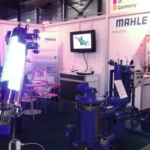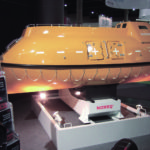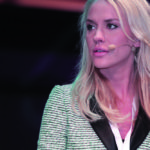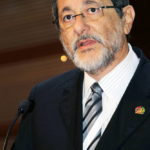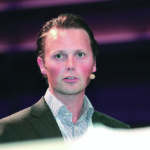Offshore oil and gas technologies and environmental solutions stood in the centre
of Oslo’s shipbuilding fair. It attracted a record number of delegates and featured key industry players.
In its 23rd edition, Europe’s second largest ship building fair, the Nor-Shipping, attracted more visitors and exhibitors than ever[ds_preview]. At an exhibition space of 22.500 m2, around 1.100 companies from 53 countries showed their products and solutions at Oslo’s Norges Varemesse – an increase of 15 % compared to 2009. This number and also the total turnout of more than 33.500 delegates to the exhibition underlined impressively that the crisis of the shipping industry is over.
While two years ago the Nor-Shipping had taken place in the aftermath of the eruption of the global financial system, it now focused again an core topics like the offshore oil and gas market as well as environmental solutions, for instance ballast water treatment, LNG and duel fuel engines or new hull designs, which make ships more energy efficient. »The focus on environmental issues is returning, and growing stronger than before«, said Morten Fon, CEO of Jotun. »When the recession war at its nadir, short-term cost-saving was everything. We’ll see that change again, as owners take a long-term perspective on environmental performance and investments to reduce fuel consumption. Sustainability is back«, said Fon.
Oversupply in VLCC market
Parallel to the exhibition itself highlights certainly were the opening and offshore conferences, which featured key industry players and the most significant topics. A lively discussion about the tanker market took place in the opening conference under the provocative headline »What’s next?«. This industry segment traditionally is of higher interest in Norway than for instance in Germany, as the Norwegians hold a major market share in the tanker business.
Tor Olav Trøim of Frontline admitted frankly that the tanker majors have »committed suicide« by »stupidly« ordering too much tonnage in the past. He didn’t see a quick recovery of the VLCC market and pointed out, that every new order today, placed either to use the recent low shipyard price level or motivated by »greener«, more efficient technology, would increase the oversupply situation for years. Trøim named gas (LNG) shipping as the only light in the tunnel, for which he sees an »undershipped« trade very soon, in particular taking into account that the LNG transport volumes grow in the wake of the Fukushima nuclear disaster with 12 % while the fleet only grows by 9 %. LNG would also be the much cheaper shipping fuel considering the difference for the barrel oil worth over US$ 100 compared to its energetic gas equivalent for actually US$ 25. However, a broad world wide use of LNG as shipping fuel seems to be »a decade away«, Trøim said.
Peter Evensen, CEO of Teekay Corp, another large tanker operator, painted a brighter picture. Noting population growth, the IEA forecast of an increase of the world energy demand by 36 % until 2035 and Clarkson’s projection of a stable seaborne trade with an average growth of 4 % during the next 10 years, Teekay perceives the actual rate crisis as a chance for active players. Nevertheless, owners will have to understand that in the future 75 cent of each earned US$ will be due for bunker fuel, while they are used to pay 25 cent of each earned 75 cent. Teekay’s policy is »hedging the bets« between oil and gas shipping as well as being flexible to participate in changing trends. Evensen mentioned as an example for such changing trades that now cotton fabrics from Louisiana are exported to China.
China was a major topic in the discussion between the panellists of the first roundtable, among them also Jotun’s Morten Fon, Peter Aker, managing partner RS Platou, Hans Christian Kjelsrud of Nordea Bank and Yngvil Åsheim, BW Gas. Some suspected that China’s motivation to attract so many VLCCs for their national shipyards’ order books could be also the intention to keep the tanker rates low for import cost sake. Others agreed that China’s intention to control the entire logistic chain including own ships would finally lead to more ships needed, due to the implementation of a separate but not fully loaded logistic system.
Africa as a driver for shipping
In a second round the next generation of shipping leaders discussed opportunities and threads for the future shipping world. They included Thomas Wilhelmsen of Wilh. Wilhelmsen Group, Cecilie Fredriksen of Frontline, Brigitte Ringstad Vartdal of Golden Ocean, Konstantinos Sistovaris of Stealth Gas, Leon Patitsas of Atlas Maritime and Saravana Sivasankaran of the Siva Group. Sivasankaran stated that commodities would lead the next super cycle and highlighted Africa as a sleeping giant and the coming driver. Africa is one of the world’s largest mineral bases and has huge quantities of fresh water sources. With plenty of fertile land it could become the food bowl of the world and a growing, increasingly wealthier population. Already 15 % of the world’s people live in Africa today – they could stimulate a new demand pull in infrastructure investments and consumer goods. It can be observed that China, but also other main players are investing real money in Africa these days.
Brazil’s offshore plans
Brazil stood in the center of the offshore conference. Maybe the most prominent speaker in Oslo, Sergio Gabrielli of Petrobras, presented the offshore plans of Brazil, a large and growing emerging consumer market as well as the largest non-OPEC oil country. The total investment in the years 2010–14 is planned with US$ 224 bn, whereas 95 % is earmarked for Brazilian companies. Furthermore, 30 % of all shipping crews must be Brazilian nationals. This legislation has motivated almost all oil and gas majors as well as the main players of the shipbuilding and offshore equipment industry to invest in joint ventures in Brazil, although some top managers comment that »the party is already over now«. The opportunities were seen in the geopolitical stability, economic growth as well as the huge potential of hydrocarbon and bio fuels. However, the challenges are the critical status of resources in all categories (goods, services and human), financing and the integration of energy.
The Brazilian shipbuilding industry has today almost 60.000 direct workers, an increase by factor 30 since 2000. 210.000 more qualified professionals will be needed in the Brazilian offshore industry until 2014. Under these circumstances the attending representatives of Norwegian offshore supply shipping operators seriously doubted that the stipulated Brazilian crew share could be trained and recruited in the coming years.
Avoiding human error
Brazil’s exploration projects in the Campos basin are pioneering the deep water challenges. Works are actually done in more than 2,000 m water depth, with more meters to come. It became clear during the conference that there will definitely be offshore oil and gas exploration and oil production beyond the »Deepwater Horizon« accident. In a panel including speakers from the US Coast Guard, DNV, BP Shipping, Intertanko and Farstad Shipping the main conclusions were that more dedication must be invested in avoiding human error in the operation procedures and that risk management during operation must reach the same quality level as it already has in the financial field.
In his keynote Pete Miller of National Oilwell Varco explained the main fields of new offshore technologies to be developed. Automation and robotics is needed both for above and under the surface operations, e.g. the automation of drilling operations to exclude human fatigue and errors, but also for the deep water operations with autonomous underwater vehicles (AUVs). Petrobras added the need for easier controls for AUVs. A big challenge is the integration of all available information on board a rig in a one man display station, which should in the future be of the same standard structure and hierarchy for all rig types and operators, to avoid errors of new personnel. More powerful blow-out-preventers are also on the agenda as more flexible mooring and dismantling systems for FPSOs. But Miller said that the »holy gral« of new technologies would be remote monitoring and operation, with the vision of totally automated systems.
Jon Arnt Jacobsen, Chief Procurement Officer of Statoil ASA, defined the future Statoil growth areas with harsh environment, deep water, heavy oil and the gas value chains. He pleaded in favour of a better and more transparent development and project cooperation between oil majors, vessel and rig operators as well as offshore technology industry, because the supplier cost would be dominating, in magnitude of 60 % of the total operation and maintenance cost, 90 % of the construction and modification cost and even 95 % of the drilling and well cost.
The participants left the conference fully convinced that the offshore oil and gas industry is still one of the largest entrepreneurial and technical challenges, but soon accompanied by offshore renewable energy generation and deep sea mining.
Contribution: Nikos Späth
Michael vom Baur







